I’m working on the layout for an embroidered autumn table runner.
I mentioned this project last week in this article.
Today, I’ll show you my idea for the runner, we’ll chat about what’s wrong with it so far (as evidenced in the photos), and we’ll talk about how to fix it.
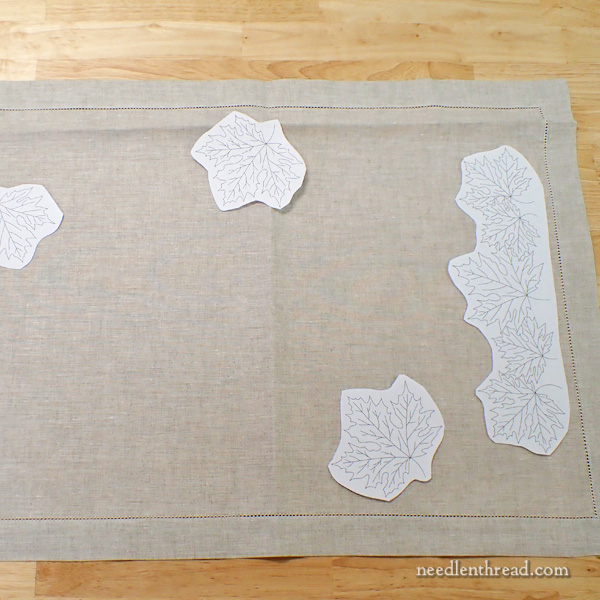
I’m using a pre-finished linen blank (I wrote about them here) for the ground fabric for this project.
The main advantage of using linen blanks is this: once the embroidery is finished, the runner is finished. It can go straight from the embroidery process to use on the table pretty quickly!
Now, I could just use the linen runner by itself on my table, as it is. I could slap a colorful autumn centerpiece on the table, on the runner – maybe fresh flowers or a combination of flowers and leaves and gourds and such – and it would be lovely. Because it’s a very high quality linen, it’s quite good enough to stand on its own as a beautiful table accent.
But what’s the fun in that, hm? I mean, if you can embroider it… embroider it! says I.
So that’s my plan.
Determining the Layout
As nice as it would be to rush on into the stitching part, I feel obliged to be careful while considering the layout of the design. After all, these linens aren’t inexpensive. So I need to get the layout and subsequent transfer Just Right.
The rule in sewing is always “measure twice, cut once.” In stitching, it’s similar: test the layout about ten or a hundred times, and then transfer it.
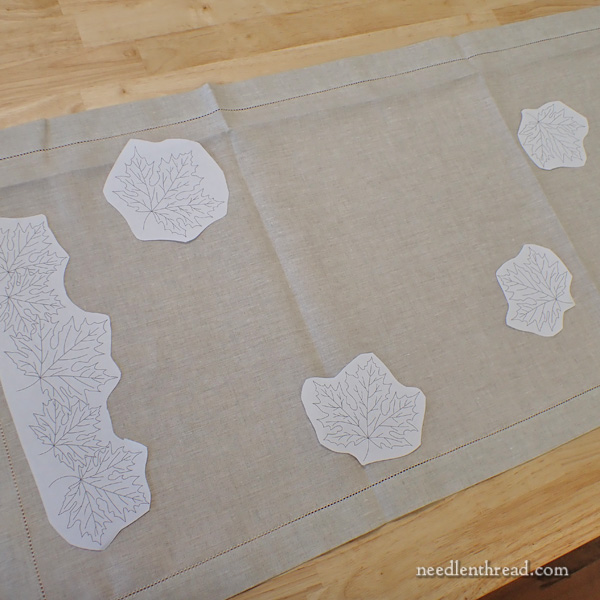
So I started by printing my design and cutting the elements out roughly, so I can see how things will work out on the runner.
Each end of the runner will feature a line of overlapping autumn leaves (they’re all maple leaves) just inside the short hemmed end.
Then, down the middle of the runner, I want to scatter individual leaves.
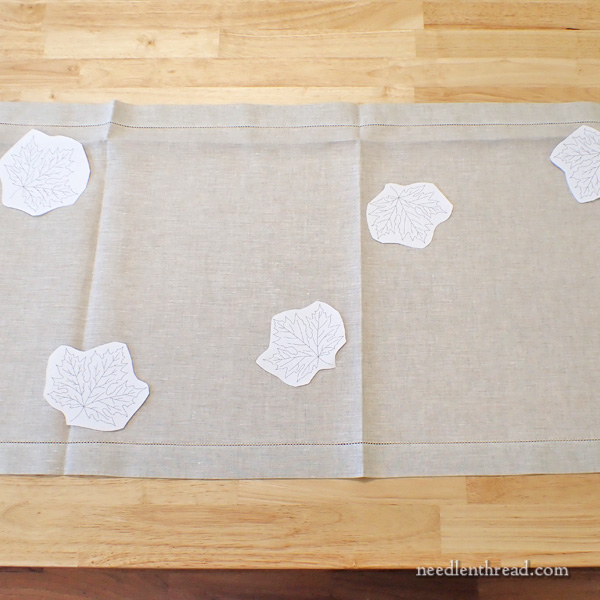
Even though these paper cut outs look like they’ve just been haphazardly placed, they took some doing. I’ve placed them a dozen times, and moved them about here and there.
But no matter how I place them, I don’t like them.
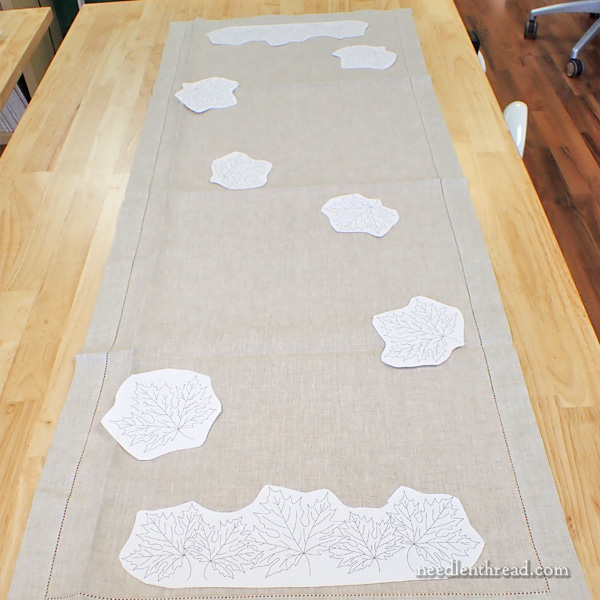
And I’ll tell you why I don’t like them.
I don’t like them because there are six leaves.
Make It Odd!
When you’re designing something that has individual elements in it, odd always works better than even. An odd number of elements is generally more pleasing to the eye than an even number.
I’m not exactly sure why this is so, but I suspect it’s because, when something is even in number, our minds tend to expect symmetry. When symmetry isn’t there, it looks “off.”
In most designs of this ilk, where symmetry is not the desired end result, a certain freeness is more pleasing to the eye.
You can achieve a much freer, more natural looking layout if you go for odd rather than even, when it comes to the number of elements in the design.
To fix the problem, then, I’ll be adding another individual leaf to the center section. I’ll go with seven leaves, because five leaves won’t give as much coverage as I’d like.
I’ll likely reduce the size of the leaves as well. I don’t want the individual leaves to dominate over the size of the leaves on the ends. That would look silly.
The set-up for this project is one item I plan to dispatch this week. The stitching on it will happen here and there, now and then. We have several other slightly more important projects going on in the studio, so I’ll be embroidering the linen runner in the evenings, at home.
But I’ll share tips and techniques along the way, never fear!
Happy Monday, my friends!



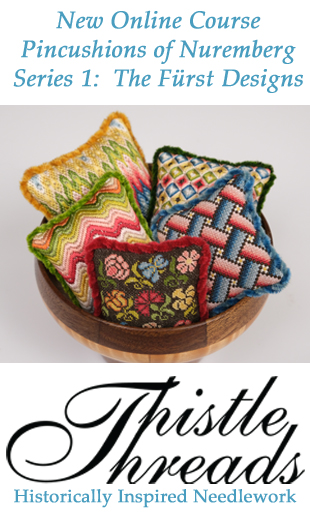
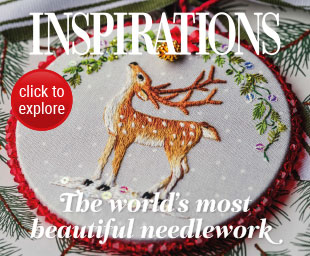
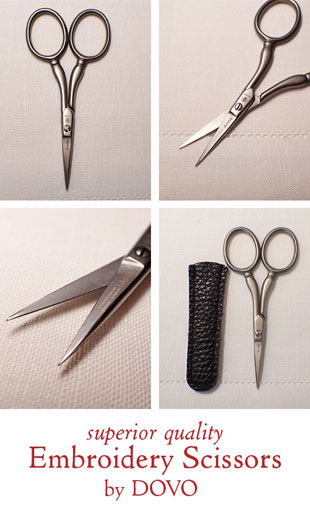


Mary,
I truly understand your comment about ‘odd’ numbers. However, as there are 5 leaves in the motif at the end of the runner, if you have 5 or 7 scattered on the rest of the mat, then there will be an even number of leaves on the runner/mat as a whole.
You could colour in the leaves so that your eye isn’t tricked into seeing the even number of leaves.
Heather
It’s really more about the grouping. You don’t really see those strips of leaves on the short ends as individual elements. The scattered elements are quite obviously individual, separate from the design on each end, though, so if they are even in number, then you expect symmetry. Symmetry is ok, if that’s what you’re after, but if you’re trying to create a scattered look, symmetry doesn’t work so well.
And I now see that you have the group of 5 at each end which is now more tricky – does your eye interpret the motif at each end as 1 motif or as 5 leaves.
I guess that either way you need to have an odd number of leaves down the open area.
Heather
Yes. Odd is correct. It’s that way when you paint a picture. If you paint a seascape with a ship, you paint one ship. If you want more than one ship, you must have an odd number of ships. Or anything else that is the focal point of your painting. 🙂 And you’re “painting” your linen with embroidery. Same principle. 🙂 Looking forward to seeing the finished runner!!
I think you’ve mentioned in the past altering the size of the scattered elements ~ so maybe 5 large and 4 medium, or 3 large, 3 medium and 3 small…
Good thinking, Sara. But golly, I’m so lazy. LOL! I just went with the two sizes – large and not as large.
Toujours aussi magnifique vos broderies. Merci
🙂 Merci, Eliane!
Hi Mary, Have you thought of an open lacey concept where the leaves are randomly jointed together at a junction leaving open spaces instead of on a solid background?
I was told about odd numbers looking better than even#’s. When I create a display of my vintage items I follow this *rule*. I think you’re right about odd & even numbers and the brain’s sense of symmetry. If you have 4 items your brain expects 2 on one side and 2 on the other, I think it looks better because it’s not expected, therefore, it’s more interesting. I think your runner will be lovely. Will it be offered as a project when you settle on the design?I don’t want to commit to a whole tablecloth, so a runner seems perfect, small enough to be portable, but adds enough pizazz to a simple Thanksgiving table. I’d probably add some seasonal decor like small pumpkins, etc… I’m originally from New England and I miss the brilliant foliage. I’d love to bring some of that inside here in FL.